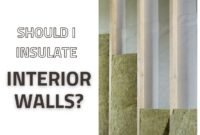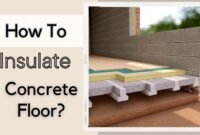You may want to know how to insulate a garage ceiling rafters, especially if you’re considering a home improvement project. If you’ve already insulated the walls of your garage, insulating the ceiling can further enhance energy efficiency.
Understanding the pros and cons of different types of insulation, such as spray foam insulation, is crucial in determining if it’s worth it.
If you leave the garage uninsulated, it may lead to an inefficient outcome for cooling and heating. Read on if you want to know more about garage rafter insulation.
Read also: Pros And Cons of Insulating Garage
Reasons to Insulate the Ceiling Rafters
Garages with open rafters are becoming increasingly popular due to their low cost and impressive resilience and durability. This design is ideal for maximizing garage space while making it energy-efficient.
Adding insulation, such as batt insulation or spray foam insulation, can significantly reduce energy loss and improve the overall comfort of the space.

You should know that insulating the door and walls alone won’t be enough. It is crucial to insulate the ceiling too, as heat can easily escape through the roof and ceiling.
Using spray foam insulation can effectively seal these areas, preventing heat loss and maintaining a consistent temperature inside the garage. Unfortunately, not many homeowners are aware of this condition.
Read also: R13 Insulation For Basement Walls
They believe that insulating the walls alone would be enough to increase the energy efficiency factor. However, if you want to improve its efficiency for the longer term, you should seriously consider insulating the rafter too.
The Best Rafter Insulation
Several options stand out when considering the type of insulation for garage ceiling rafters. One popular choice is batt insulation, which includes fiberglass batts or rigid foam. Another effective option is spray foam insulation, which can provide a tight seal and excellent thermal resistance.
When measuring for insulation, it’s important to accurately determine the length and width of the area to ensure a proper fit.
- Roll insulation. This kind of insulation is considered the most prevalent one. Its fiberglass fibers are batted or rolled to big fluffy batts or rolls. You will see R numbers show the level of insulation materials. Batts refer to pre-cut sheets. If you want thick insulation, find the proper R-value and correct thickness.
- Aluminum layer or rigid foam. A thin sheet or stiff aluminum foam would be enough if you live in an area with minimal insulation.
- Cellulose insulation. This insulation comprises loose material or fibers being blown into its place by using a blower. It would add the ceiling’s joist cavities above the finish or drywall. It’s perfect for finished ceilings with limited space and won’t be appropriate for the unfinished ceiling. The insulation needs a flat surface to rest on.
These materials effectively reduce heat transfer through the ceiling, making your garage more energy-efficient. Fiberglass batts, in particular, are easy to install and can fit snugly between the rafters, providing excellent insulation coverage.
How to Insulate a Garage Ceiling Rafter
You will need some essential stuff to perform the installation, such as:
- A utility knife
- Gloves
- Insulation material
- Ladder
- Sharp cutter
- Staple gun
- Dust mask
The steps to insulate a garage ceiling with batt insulation are straightforward and can be accomplished with basic tools and materials.
However, if you’re considering spray foam insulation, it’s important to understand the specific requirements for installation, such as ensuring a friction fit between the insulation and the rafters.
- Measure the area. You will have to measure the area so you can start the process. You can also check for hollowed areas or damage, such as water damage, termites, or others. If there are broken areas, you want to repair those first.
- Clear the garage. You want to be able to do the insulation without having to worry about damaging your stuff.
- Install the rafter vents. This is when you need a sharp knife – to cut the holes. This is also when a staple gun is needed to add the vents to the top area of the rafters.
- Install the insulation (beneath the rafters). The insulation should be installed right beneath the vents. Make sure that the front area is aligned with the front side (of the rafter). The sharp knife can also be used again to cut extra material from insulation material installation. You don’t have to cut the excess material, but if you want a smooth finish, it’s better to trim it out.
Before beginning, it’s important to measure the garage door and ensure that it is properly sealed, as this can significantly impact the overall effectiveness of the insulation. Additionally, when installing fiberglass batts or rigid foam, ensure they are cut to accurately fit the space between the rafters for optimal insulation.
Conclusion
While DIY enthusiasts can undertake the task of insulating garage ceiling rafters, hiring a professional can ensure a more precise and efficient installation, especially when dealing with specific types of insulation like fiberglass batts or rigid foam.
So that you know, installing the insulation rafter isn’t difficult as long as you are thorough and careful.
Professionals can also advise on the best type of insulation for your specific needs, considering factors like climate and garage usage. Remember, proper insulation improves energy efficiency and enhances the comfort of your garage space.


